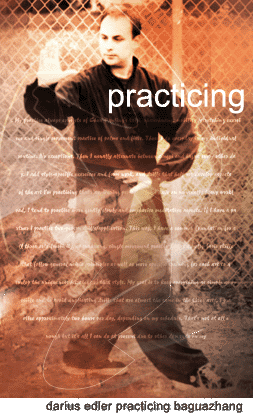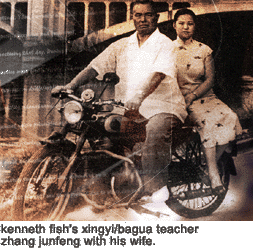|
I add style-specific exercises and form work, and drills that help me develop
aspects of the art I'm practicing that day. During periods when i have an unusually
heavy workload, I tend to practice more gently/slowly and emphasise meditative
aspects. If I have a partner I practice two-person drills/application.
My question is to those who practice all three, or even two, of the neijia.
How do you practice? Few of us have the time to practice all day and even if
we did, there's a limit to how much is good for us. How do you keep developing
in all arts? What does your routine look like?
Posted by Rick Matz on 3/4/2001 - It
seems we fall into two broad categories. There are those of us who manage to
train 3 to 6 hours a day; and those of us who manage to train 3 to 6 hours a
week. The strategies for each must be different. I imagine that someone who
is training many hours a day, has the opportunity to at least review most of
their material, and work specifically, on a few items? I would also imagine
that someone with fewer hours must spend more of their time on foundational
activites (such as standing stake), ... and then what? Mostly linked sets? I
am finding myself, because of limited time, to be putting most of my energy
into YiQuan practice lately, figuring that I'm getting the biggest bang for
the minute, by building a strong foundation.
Posted by Jason Connelly on 2/28/2001 - I
too practice the 3 arts, but it's hard to find the time I would like to devote
to it, basically my 2 hrs is 30 min ChiGung, 30 min 5 fists (3 speeds) relaxed,
stretched, fast, 30 min Single Palm Change and maybe Snake (both my Hsing-i
and Bagua are Gao style lineage) and then 30 min of Tai Chi (Yang style).
|
Posted by Kenneth Fish on 2/28/2001 - I answered
this partly under the pan gen bu string. I have learned smatterings of systems
over the past 30 some odd years (some odder than others). Some of this was to
gain different perspective on my "core" training. Other times it was to take a
breather and learn something new, or just to study with a truly talented teacher
(kung fu is kung fu, if you aquire skill it is usually applicable regardless of
the system) The systems I worked on for a long time were Xingyi (my core system),
Foshan Wingchun, Lohan Shaolin and Chen Panlings Taiji. I learned quite a bit
of Bagua and some Tongbei as well. As for what I really train in, it has changed
over the years. Before I went to Taiwan, I did Buddha Hand Wing Chun every night
for about 3 years. When I lived in Taiwan, I trained 5 hours a day, every day,
barring hangovers. Then it was mostly Xingyi and Bagua. |
|
Later
I concentrated on the Shaolin and Taiji (I learned from Mrs. Zhu in NY for 4
years. She passed away in 1984 -
she also drilled me on Bagua and Tongbei) Again, this was every day for a couple
of hours - we would alternate the training.
As I grew older, and my workload and attitude changed, I concentrated more on
Xingyi. I found that the more I really got to understand it, the less I found
myself motivated to train in Bagua (although I did some just to remember it,
and sometimes change my training for interests sake). Frankly, just about everything
Bagua had to offer I found in Xingyi, and then some. Its worth noting that in
Beijing and Shandong, most of the older Xingyi masters did just that - Xingyi.
On the other hand, many Bagua teachers felt compelled to learn or incorporate
Xingyi or Xingyi type training to teach power and stability.
Today I concentrate mostly on Xingyi - my body has grown to accomodate it ("xingyi
body"). I still teach shaolin (and the shaolin I teach has most of the content
of xingyi and taiji, just different proportions), practice it for the workout
as well (its more athletically demanding). I still do Tongbei a few times a
week - its fun and lively. Bagua - seldom, just enough not to forget the system
- I don't feel that attached to it. I'm still trying to make as much progress
in Xingyi as I can, before I become horizontally inclined (or approach room
temperature)
Posted by Tadzio on 2/28/2001- I also train all
the 3 styles, but I concentrate more on XY and Tai Ji/For this both arts, my
train is divided in :
1 - Separated movements rather then sequences.
2 - Conditioning and power training with my teacher and trees.
3 - Free tui shou.
4 - Meditation
5 - Free fighting.Usually I do Taijji and XY everyday and Bagua every other
day.
(Posted
by Bev on 2/28/2001) - Interesting
question ... here's my take ... Though i know some tai chi, i very seldom practice
it - just bagua and XY provide more thatn i can realistically practice in the
time i have. I usually concentrate more on one art for a period of time - say
one month (five days bagua, two days XY or vice versa). After a month, i'll
switch over if i feel it is needed.
Basic standing practice is every day, then some single movement - maybe just
some opening and closing of the kwa or rise, fall, drill, overturn type stuff.
After that, i take a palm change or XY fist and drill that (trying to incorporate
the single movement practice i have done). Then i look for the application of
the movement, drill some shadow boxing with it and then try and put that feeling
back into the form. I always end off with a little more standing to make sure
i don't take any fighting mentality back into "real" life.
Posted by SA on 3/1/2001 - On the theoretical/philosophical
side of the equation I was instructed to follow an order in training the various
arts. This order is based on the use of the Tai Chi Tu (symbol) moving from
the neija to weija. According to this order, morning practice would begin with
Tai Chi, followed by Bagua followed by (what some refer to as the "bridging
art") of XingYi. Late afternoon or evening practice would consist of weija arts.
Back when I was semi-retired (read: unemployed) and training 7/8 hours a day,
this worked rather well.
As to why study all three. Each isolates one of the three major fighting tactics,
all of which can be found in the shaolin arts (many practioners of which don't
even know it). This is why it is considered by some to be important to train
each art separately, at least in the learning stages. If my teacher saw me practicing
Tai Chi before XingYi or Bagua class, he would tell me to stop. Simply put,
there was a concern that I would enter class with a Tai Chi mind as opposed
to a XingYi or Bagua mind. This is part of good Yi training (more on this below)
I believe there is a difference in mind set within the Neija arts . If they
were all the same there wouldn't be three arts. A xingyi punch just feels different
from a bagua or tai chi punch. So, mind is important. Of course, as you progress
in your study your arts begin to blend and you make use of all of your tools.
But presumably you will also have developed the Yi to go along with the development
in your skill level, thereby enabling you to shape your movements with the desired
energy quickly [Mind-Form Boxing in the broadest sense of the word - jungo chuan
(excuse my transliteration)].
Lastly, in my limited experience having studied both the neija and weija arts
has stood me in good stead in fighting and sparring people who have been exposed
to only one art form. The same movement may appear in all art forms, but studying
how that movement is viewed in all art forms develops enlightenment of movement.
In short, different appreciation of movement comes with broad exposure to the
arts.
Posted
by Shun Quan on 3/2/2001 -
I want to share my experience in (1) three arts (2) priority and time.
(1) Why three arts. The arts that I learned is imperial bagua chuan, Heibei
xing yi chuan and Yang tai ji. Each art prosess a unique ways in training neigong,
jing and strategies. The common gates that connect the three arts together are
the most basic neigong principal, the difference being the advancement after
that. The fun thing is that as you learning the other art , it certainly open
up the understanding of basic of the other. The more exciting thing to me is
that the understanding of the entry gates that the different arts take. You
suddendly realize that there are more than one gate. Even though they lead to
the general principles but from different method doing it. This is in term of
neigong. In term of tactics, it is the same. A similar comparsion is the variation
similiar act of peng in Tai Ji and Mao Si lien (cat wash face) in Xing Yi and
snake palm in imperial bagua. Three ways of doing things (almost similiar),
but three different jings involved with different nature of body machanics.
Because of this reason, maintaining the three identities of three arts is essential.
This is to be loyal to the principles of what the three arts can offer and be
able to teach/build the entry level students. Mixing them of course is ok, but
more of delicated identities will be lost. I always imagine the three arts being
three sphere intersect in a share area and different in others. The more focuse
we devote on the share area or single art, the other distinct characteritics
will fade always through time. To me, it is essential to maintain three.
(2) My priority is family first: then finally the arts. The only way I can accommodate
my training requirements as secondary is cut into my sleep hours. Sleeping for
5 hours is enough. 2 - 2.5 hours for training. Training is done when everyone
is asleep. Either late at night or very early in the morning. I found breaking
training into session of 2 or even 3 is helpful. Training whenever time is permitted
or possible.
The attentions are divided into two phrases during a day of activities. One
is devoted to basics of all three. Two is focusing on different specialties
of one or two or even three arts. Tai Ji is being the mean of song and yield;
xing i is being aggressive; bagua is being element of changes. The ability of
being able to switch between mindset is crucial. The training is never leave
any art out at all. Just the emphasis on different depth is different every
period of time.
|


